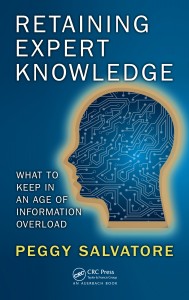
I couldn’t wait to get out the word that my new book, the latest in the Working with Experts series, is available for sale today!
I’ll be doing some promotions which you will hear about later, but for now here’s the description on Amazon:
Retaining Expert Knowledge: What to keep in an age of information overload covers two major topics central to capturing and transferring expertise in organizations:
- Methodology and best practices for interviewing subject matter experts (SMEs) to capture their knowledge
- Identifying the SMEs to interview
The more critical problem is identifying the SMEs and the knowledge that needs to be captured.
One reason identifying the right experts is now so important is that in the next 10 years, the largest recorded exit of talented and knowledgeable workers from organizations will occur as baby boomers retire. In their wake, they leave their former employers understaffed and, even scarier, under-informed. Identifying the right SMEs is also critical because of the rapid acquisition of new knowledge. Some estimates say knowledge now doubles every two years, so it is crucial each organization identifies its journey and catalogues it individually and collectively.
This book provides managers with answers to the following questions:
- Are we talking to the right subject matter experts?
- What knowledge should we capture?
- What knowledge needs to be captured immediately as opposed to eventually?
- If we have limited resources, which experts are most important to speak with first?
Every organization has a history, a culture, and knowledge that may have lost its current relevance but not its importance. It is that broader vision of capturing knowledge, which this book addresses. It guides readers on how to preserve corporate knowledge and provides tools to assess organizational circumstances and judge the value of the resources to capture.
Retaining Expert Knowledge is a training resource, but it is also a business resource. As knowledge proliferates and organizational culture rapidly changes, now is the time to step back and determine what has been important to your organization’s success, where the organization is today, and what it will take to stay in the game tomorrow.
Your company houses knowledge, skills, attitudes, intellectual property, trade secrets, company culture, and individuals who will never be replicated exactly as they are today. Because they have demonstrated value in the past and are demonstrating value today, these treasures are worth preserving. This book shows how to preserve these valuable assets today for tomorrow’s successes.
You can buy this wherever you normally purchase your books.
Here’s a link directly to Amazon.









